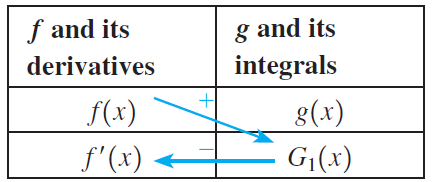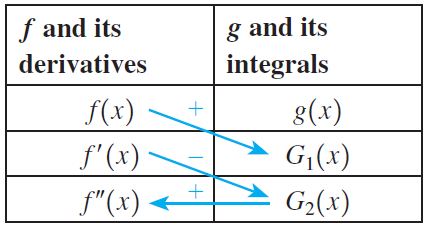Consider the integral f(x)g(x) dx, where f and g are sufficiently smooth to allow repeated differentiation
Question:
Consider the integral ∫ f(x)g(x) dx, where f and g are sufficiently “smooth” to allow repeated differentiation and integration, respectively. Let Gk represent the result of calculating k indefinite integrals of g, where the constants of integration are omitted.
a. Show that integration by parts, when applied to ∫ f(x)g(x)dx with the choices u = f(x) and dv = g(x)dx, leads to ∫ f(x)g(x) dx = f(x)G1(x) - ∫ f'(x)G1 (x) dx.
This formula can be remembered by utilizing the following table, where a right arrow represents a product of functions on the right side of the integration by parts formula, and a left arrow represents the integral of a product of functions (also appearing on the right side of the formula). Explain the significance of the signs associated with the arrows.

b. Perform integration by parts again on ∫f'(x)G1(x) dx (from part (a)) with the choices u = f'(x) and dv = G1(x) to show that ∫ f(x)g(x) dx = f (x)G1(x) - f'(x)G2(x) + ∫f"(x)G2(x) dx. Explain the connection between this integral formula and the following table, paying close attention to the signs attached to the arrows.

c. Continue the pattern established in parts (a) and (b) and integrate by parts a third time. Write the integral formula that results from three applications of integration by parts, and construct the associated tabular integration table (include signs of the arrows).
d. The tabular integration table from part (c) is easily extended to allow for as many steps as necessary in the integration-by-parts process. Evaluate ∫ x2e0.5x dx by constructing an appropriate table, and explain why the process terminates after four rows of the table have been filled in.
e. Use tabular integration to evaluate ∫ x3 cos x dx. How many rows of the table are necessary? Why?
f. Explain why tabular integration is particularly suited to integrals of the form ∫ pn(x)g(x) dx, where pn is a polynomial of degree n > 0 (and where, as before, we assume g is easily integrated as many times as necessary).
Step by Step Answer:

Calculus Early Transcendentals
ISBN: 978-0321947345
2nd edition
Authors: William L. Briggs, Lyle Cochran, Bernard Gillett





